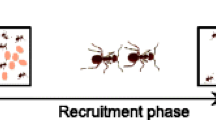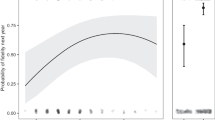Abstract
During decision − making, animals consider not only the current but also the past quality of options. For example, when humans evaluate performance (e.g. sales) of employees, they do not only consider the average performance but also the trend of performance; ascending performance is often viewed as more favorable than descending performance. In our study, we test if non-human animals have a similar bias when they are evaluating options using house-hunting by the acorn ant, Temnothorax curvispinosus, as our model system. Our data show that when nest-site quality is static over time, ant colonies tend to prefer the nest site which was better (i.e. darker) between two nest options. However, when the nest quality changes over time—one improves and the other worsens—more colonies choose the low-quality, but improving, nest than the high-quality, but worsening, nest. These results suggest that a continuous change of option quality may influence evaluation. We discuss alternative explanations for our results, possible mechanisms, and potential ecological benefits for keeping track of the nest-site quality.



Similar content being viewed by others
Data availability
The data and R code are available online (doi:https://datadryad.org/stash/share/gokTGmFJjlBptNW-CC8SKtINOhbFDoBdgRqFLKYsSeE).
References
Bateson P (1983) Mate choice. Cambridge University Press
Bengston SE, Dornhaus A (2013) Colony size does not predict foraging distance in the ant Temnothorax Rugatulus: a puzzle for standard scaling models. Insectes Sociaux 60:93–06
Bhatkar A, Whitcomb WH (1970) Artificial diet for rearing various species of ants. Fla Entomol 53:229–232
Bitterman ME (1976) Incentive contrast in Honey bees. Science 80–:191:380–382
Blanchard TC, Wolfe LS, Vlaev I et al (2014) Biases in preferences for sequences of outcomes in monkeys. Cognition 130:289–299
Burns DDR, Sendova-Franks AB, Franks NR (2016) The effect of social information on the collective choices of ant colonies. Behav Ecol 27:1033–1040. https://doi.org/10.1093/BEHECO/ARW005
Couvillon PA, Bitterman ME (1984) The overlearning-extinction effect and successive negative contrast in honeybees (Apis mellifera). J Comp Psychol 98:100–109. https://doi.org/10.1037/0735-7036.98.1.100
DeNisi AS, Stevens GE (1981) Profiles of performance, performance evaluations, and personnel decisions. Acad Manag J 24:592–602
Dornhaus A, Franks NR, Hawkins RM, Shere HNS (2004) Ants move to improve: colonies of Leptothorax Albipennis emigrate whenever they find a superior nest site. Anim Behav 67:959–963
Franks NR, Pratt SC, Mallon EB et al (2002) Information flow, opinion polling and collective intelligence in house-hunting social insects. Philos Trans R Soc B Biol Sci 357:1567–1583
Franks NR, Mallon EB, Bray EH et al (2003) Strategies for choosing between alternatives with different attributes: exemplified by house-hunting ants. Anim Behav 65:213–223
Franks NR, Stuttard JP, Doran C et al (2015) How ants use quorum sensing to estimate the average quality of a fluctuating resource. Sci Rep 5:11890
Geiselhardt SF, Lamm S, Gack C, Peschke K (2010) Interaction of liquid epicuticular hydrocarbons and tarsal adhesive secretion in Leptinotarsa decemlineata (Coleoptera: Chrysomelidae). J Comp Physiol A 196:369–378
Kacelnik A, Bateson M (1996) Risky theories—the effects of variance on foraging decisions. Amer Zool 36:402–434
Kahneman D, Tversky A (2018) Prospect theory: an analysis of decision under risk. Exp Environ Econ 1:143–172
Langridge EA, Franks NR, Sendova-Franks AB (2004) Improvement in collective performance with experience in ants. Behav Ecol Sociobiol 56:523–529
Mallon EB, Pratt SC, Franks NR (2001) Individual and collective decision-making during nest site selection by the ant Leptothorax Albipennis. Behav Ecol Sociobiol 50:352–359
Möglich M (1978) Social organization of nest emigration in Leptothorax. Insectes Soc 25:205–225
Pratt SC (2005) Behavioral mechanisms of collective nest-site choice by the ant Temnothorax Curvispinosus. Insectes Soc 52:383–392
Pratt SC, Sumpter DJT (2006) A tunable algorithm for collective decision-making. Proc Natl Acad Sci U S A 103:15906–15910
Santos C, Rajagopal S, Sanabria F, Sasaki T (2022) Reversal learning in ant colonies. Res Sq Prepr. https://doi.org/10.21203/rs.3.rs-2857462/v1
Sasaki T, Pratt SC (2013) Ants learn to rely on more informative attributes during decision-making. Biol Lett 9:20130667
Sasaki T, Pratt SC (2018) The psychology of superorganisms: collective decision making by insect societies. Annu Rev Entomol 63:259–275
Sasaki T, Granovskiy B, Mann RP et al (2013) Ant colonies outperform individuals when a sensory discrimination task is difficult but not when it is easy. Proc Natl Acad Sci 110:13769–13773
Sasaki T, Stott B, Pratt SC (2019) Rational time investment during collective decision making in Temnothorax ants. Biol Lett 15:20190542
Stephen DW, Krebs JR (1986) Foraging theory. Princeton University Press, Princeton
Stroeymeyt N, Giurfa M, Franks NR (2010) Improving decision speed, accuracy and group cohesion through early information gathering in house-hunting ants. PLoS ONE 5:e13059
Stroeymeyt N, Franks NR, Giurfa M (2011a) Knowledgeable individuals lead collective decisions in ants. J Exp Biol 214:3046–3054
Stroeymeyt N, Robinson EJH, Hogan PM et al (2011b) Experience-dependent flexibility in collective decision making by house-hunting ants. Behav Ecol 22:535–542
Tyler K, Vassie D, Sasaki T (2023) Data for the paper The history of option quality affects nest site choice in the acorn ant, Temnothorax curvispinosus. In: Dryad
Wendt S, Strunk KS, Rgen Heinze J et al (2019) Positive and negative incentive contrasts lead to relative value perception in ants
Wendt S, Strunk KS, Heinze J, Roider A, Czaczkes T (2019b) Positive and negative incentive contrasts lead to relative value perception in ants. eLife 8:e45450
Wüst M, Menzel F (2017) I smell where you walked - how chemical cues influence movement decisions in ants. Oikos 126:149–160
Acknowledgements
T.S. was supported by NSF grants (#2118012 and 2310983) and Templeton World Charity Foundation (#30059) and K.T received a CURO (Center for Undergraduate Research Opportunities) Fellowship at University of Georgia to conduct this study.
Author information
Authors and Affiliations
Corresponding author
Ethics declarations
Competing interests
The authors declare no competing interests.
Additional information
Publisher’s Note
Springer Nature remains neutral with regard to jurisdictional claims in published maps and institutional affiliations.
Electronic supplementary material
Below is the link to the electronic supplementary material.
Rights and permissions
Springer Nature or its licensor (e.g. a society or other partner) holds exclusive rights to this article under a publishing agreement with the author(s) or other rightsholder(s); author self-archiving of the accepted manuscript version of this article is solely governed by the terms of such publishing agreement and applicable law.
About this article
Cite this article
Tyler, K., Vassie, D. & Sasaki, T. Does the history of option quality affect nest site choice in the Acorn ant?. Insect. Soc. (2024). https://doi.org/10.1007/s00040-024-00969-0
Received:
Revised:
Accepted:
Published:
DOI: https://doi.org/10.1007/s00040-024-00969-0




